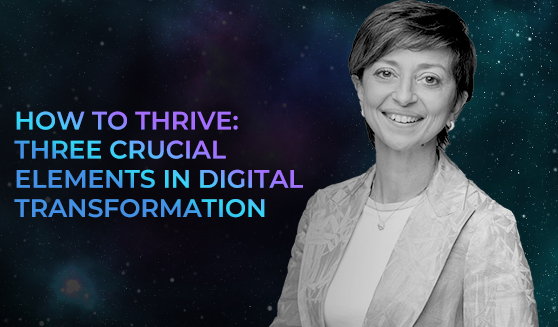
We all know that digital transformation has accelerated since the start of 2020. But the next wave of transformation is already underway — and the question that Adele Trombetta (Head of Customer Experience at Cisco EMEAR) asked at #LEAP22 was whether your aim is to survive it, or thrive in it.
The pandemic expedited the process of tech acceptance and adoption among consumers. As Think With Google put it, this means that companies now need to reset, pivot, and think big — because as users become accustomed to hyper-convenient tech, the demand for even more seamless solutions for daily tasks and experiences is only going to grow.
Contactless payments proved to be a standout tech solution during the pandemic, with adoption in Saudi Arabia among the highest in the world at 94%, according to Saudi Central Bank. The reasons for this are pretty self-explanatory; contactless offers a safe, zero-touch way to pay for goods and services. But Trombetta pointed out that while a contactless transaction is very simple from a user perspective, the processes that enable it are very complex — “and this is where the beauty of the technology comes,” Trombetta said, “because the technology embraced the complexity and translated that into a simple, seamless user experience.”
When a user gets used to that ease of life, “they start asking for more complex services.” And this means that technology is the key enabler for any company’s success. So much so that “even the companies that do not have technology as their main business…should act somehow as a technology company.”
However, simply adopting and integrating the latest available technology for your customers is not enough. You might survive for a while, but not for a very long time, and you certainly won’t thrive. Companies in all industries have to evolve and transform with technological change in order to cultivate future resilience.
How does a company transform?
Cisco is a great example of a company that transformed from the inside out, in response to consumer needs. Well known as an infrastructure technology leader, Trombetta said it was confronted with a shift in the market, “from technology centricity to experience centricity.” Instead of learning about the tech that Cisco could provide, customers wanted to learn about the improved experiences they could benefit from.
So, Cisco transformed from a service organization to a customer experience organization; “this was a kind of revolution for us, a paradigm shift in how to approach the market,” Trombetta said, “we are not anymore going and talking to customers about technology; we started changing the conversation,” focusing instead on what really matters to each business that Cisco serves.
This kind of shift is, of course, not as simple as it sounds. For Trombetta, it highlighted the reality that business transformation involves three crucial elements beyond the tech:
People
You have to build out your team with people who are in the mindset for transformation. They’ve got to be hungry for it. And you have to create a culture that allows them the space to grow: “We need to allow them to fail, but fail fast,” Trombetta noted, “because if we fail it means we’re evolving, and if we fail fast it means we learn from that, and next time we’ll be much better.”
And as well as the people within your team, you’ve got to consider (constantly, always, eternally) the people your company is serving. Now more than ever, connecting directly with customers to understand how they’re feeling, what they want, and what they’re struggling with, is an essential practice for business resilience. As Nicole Corbett (Director of Intelligence at NielsenIQ) said of COVID-19 in 2020,
“There is little doubt that consumers’ uptake of technologies to stay informed and safeguard their health can instill confidence in a stressful period, and this may be the unforeseen catalyst to assert broader, longer-term adoption of technology platforms and solutions.”
Corbett hasn’t been wrong — and the businesses (and industries) that put people first at the start of the pandemic are the ones that are thriving now.
Platform
Platform starts with intelligence and infrastructure, right up to the top end of the stack at user application. Within that is, of course, data: with systems in place to collect, analyse, and deploy data insights in a meaningful and effective way.
Increasingly, you have the option of tapping into external platforms to increase your company’s chance of thriving. Like SAP’s Logistics Business Network, which uses blockchain to enable businesses to initiate networks that give them visibility across the entirety of a product’s supply chain, from manufacturing to distribution.
(by the way, SAP CEO Christian Klein talked about this at #LEAP22 — watch the video here)
Planet
“We really need to have the right use of our resources,” Trombetta said. Why? Because customers care about it, and because it matters. If you’re providing any kind of technology service to other businesses, you have to consider how you can measure and minimise the carbon cost of those services — in order to help your customers meet their overall targets.
Insights from Roland Berger show that the green tech industry has outpaced earlier predictions, with global revenues in environment tech and resource efficiency expected to reach 9.4 trillion euros (more than 10.2 billion USD) by 2030, averaging at an annual growth rate of 7.3%.
Three Ps to thrive
When you get caught up in the excitement (even hype) of new tech, it’s easy to assume that integrating the latest solutions into your company’s operations will steady you for future success. You’re using the latest tech, so how could you possibly fall behind?
But the reality is that being ahead of the technology curve isn’t enough. You do also have to understand people. You do also have to invest in your platform at every level. And at this moment in human existence, you cannot neglect to weave environmental impact into all of that. Technology doesn’t drive change, it enables it. The real drivers of transformation are people, and what those people want from tech.
To thrive in the future, your company needs to be the one that distils complex technological capabilities into incredibly simple, seamless experiences for users.
As Trombetta put it,
“We need to keep transforming. And in doing that we need to bear in mind that it’s not only about technology, but about platform, people, and our planet.”








